Launceston Birth Centre [LBC] was Australia’s first private birth centre.
Founded in 1983, it continues to be run by a consumer committee and serviced by a team of private midwives.
Visit the LBC website at https://www.birthcentre.org or follow them on facebook
In the beginning…
In the year 1981, a significant increase in homebirths within the northern region of Tasmania became noticed by both the medical profession and the Board of the Queen Victoria Maternity Hospital [QVH]. It was of concern to both these groups that some of the homebirths in the area were being conducted by a lay person. At that time, women were also voicing their opinions that they wanted better choices in choosing their own midwife and place of birth. Public complaints about this were voiced on talkback radio, in newspaper articles, and at the Childbirth Education Association [CEA] Conference in Launceston in 1981.
In a conversation with Alana Street, Ann O’Byrne and Cecily Harmey described the mounting discontent about the lack of choice for birthing women in the north of Tasmania before the Launceston Birth Centre was opened. Women who wanted to avoid the potential medicalisation associated with birth in hospital had no access to alternatives, such as midwifery care in a birth centre or publicly funded home birth services. They were also not allowed to have male partners with them during labour, or visits on the postnatal ward from members of Childbirth Education Association, who offered breastfeeding support.
Ann O’Byrne described being approached by a member of the QVH Board in 1981 when she was an Executive Member of the Launceston General Hospital. He asked her if she could ‘do something’ to help the Board respond to the concerns that were being raised about the lack of choice for birthing women and the risks associated with births at home that were occurring without a qualified midwife or doctor present.
As the wife of a local politician, a former nurse, and a mother with an interest in community services for mothers and babies, Ann took up the challenge with enthusiasm. She contacted Cecily Harmey who was the midwife in charge of the birthing suite at QVH and they started exploring the feasibility of setting up a birth centre and improving the choices women could make at the QVH. Very quickly a committee was formed, with consumer representation from the Childbirth Education Association.
The Launceston Birth Centre was born out of much lobbying by the three founding members of the first committee, the executives of Childbirth Education Association (CEA), and members of the public.
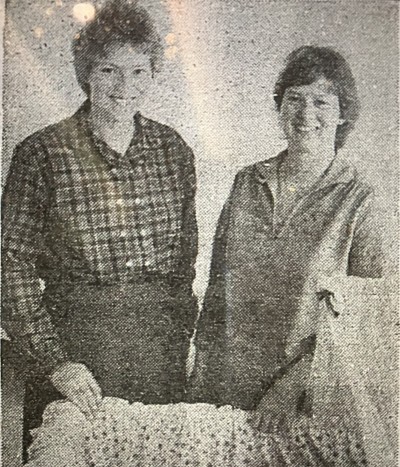
The three founding members of the LBC were Cecily Harmey (midwife), Jackie Hartnett (consumer of midwifery services and lecturer at the University of Tasmania), and Susan Eddy (accountant).
(L) Susan and Cecily are pictured in a 1983 article ‘Giving Birth in a Home-Like Setting’ published in the Launceston local newspaper The Examiner.
(R) Cecily and Jackie are pictured with baby Caroline (20 minutes old) in the April/May 1984 edition of Australia’s Parents and Children’s Magazine.
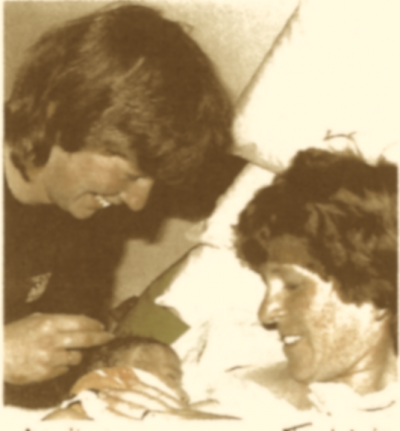
1983 – 1990 Matrons Flat in the Nurses’ Home, Queen Victoria Hospital
It took two years of hard work to establish the LBC, which opened in July 1983 as a free-standing, consumer-run, non-profit organisation, with no government grants or external funding. The hospital board of the QVH received consent from the then Minister for Health for the LBC to be based in the grounds of the hospital in the Matron’s Flat, part of the Nurses’ Home. This two-bedroom unit had its own separate external entrance and was easily accessible by car. A peppercorn rent of $40 a week was negotiated. The birth centre was furnished with equipment that was donated or funded by families supporting the LBC.
In 1983, the article ‘Giving Birth in a Home-Like Setting’ was published in the Launceston local newspaper The Examiner. It identified Jessica Rose Woodward as the first baby to be born in the LBC on August 24th 1983. Her mother, Dianne Woodward, and midwife Cecily Harmey are quoted in extolling the benefits for women and their families of giving birth in a home like setting, close to medical help if needed and with a known midwife.

In the following year, an article about the opening of the LBC also appeared in the April/May 1984 edition of Australia’s Parents and Children’s Magazine.
The early years
All births at the LBC were attended by independent midwives. Registered midwives could work at the Centre provided they did so under the authority of a doctor. The doctors who worked with the birth centre midwives were all registered with the QVH and so could facilitate transfers when necessary. The Childbirth Education Association (CEA) supported the midwives and doctors, and volunteers played a crucial part in the setting up and development of the birth centre.
The number of births in the new birth centre increased steadily over the next few years:
- In 1984, 4 births were recorded in the minutes (although the August 1984 article Birth centre gives parents a choice notes 11 births since the first in August 1983)
- In 1985, 18 births were recorded in the minutes
- In 1986, 30 births were recorded in minutes
In 1987 the first Newsletter was mailed out to all members. At the time, the independent midwives who worked from the LBC were charging $250 for ante-natal, labour and birth, and post-natal care.
In 1988, the use of the Birth Centre cost parents $110 for the first 24hours, with an additional $80 each subsequent day.
In these early days, some Midwives were paid through a barter system for their care, for example with a handmade coffee table, curtains, and a food preserving kit.
To guarantee its ongoing existence, a membership fee of $90 per annum was charged and members received monthly newsletters. Donations were abundant from grateful parents who used the Birth Centre.
Publicity campaigns included press releases in local newspapers, word of mouth accounts, radio interviews and press coverage. ‘Birth Awareness Evenings’ were hosted with displays, talks, videos and supper.
According to the annual President’s Report, March 1988-89, there was a major breakthrough in 1988 in arrangements with the Queen Victoria Maternity Hospital. When transfer to the QVH was necessary, LBC midwives were now permitted to accompany the women and remain with them on the labour ward, instead of having to wait in the foyer.
In 1989, LBC Midwives started recording birth centre births and home births in the newly-established Birth Register.
A growing acceptance of birth centres in Australia
In a local newspaper article in 1985, midwife Cecily Harmer described the successful working of the Launceston Birth Centre against the background of a growing acceptance in Australia of birth centres as a viable alternative to giving birth in hospital.
Birthing centres gaining acceptance in Australia (1985)
Cecily had recently contributed to a panel discussion at a seminar entitled The Birthing Alternative: Family Birth Centres at the Royal Women’s Hospital in Melbourne. Other contributors to this groundbreaking seminar are listed in the programme. The seminar was attended by approximately 150 people involved in birth centres around Australia. She identified that the best part of the seminar was ‘seeing so many obstetricians and midwives with a positive attitude towards birth centres’.
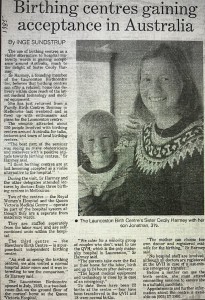
Cecily’s description of the seminar in the article includes visits to local birth centres and maternity units, and lectures by doctors from three birthing centres in Melbourne: ‘Two of the centres – the Royal Women’s Hospital and the Queen Victoria Medical Centre – operate as part of the hospital system, although they are separate from the maternity wards. They are staffed separately from the labour ward and are self-contained units within the hospital. The third centre, the Hawthorn Birth Centre, is a purpose built, independent birthing centre.’
The article Birth centres in hospitals an option captures the birthing services in Tasmania in 1987.
Commonwealth Alternative Birth Services Program funding for the LBC
The late Elaine Smallbane was an LBC midwife who was awarded Life Membership of the Australian College of Midwives for her considerable contribution to the College. At a Birth Issues conference held in Melbourne in 1994, she described the history of the LBC and the period of time when ABS funding enabled. The presentation was published in Birth Issues (Smallbane, E. (1994). Launceston Birth Centre: A Free-Standing, Consumer Managed Birth Centre. Birth Issues, 3(5), 9-12) and identifies that the LBC requested funding ‘to increase its accessibility to all women, including those previously excluded by financial constraints, and to upgrade the physical environment and equipment at the Centre. $64,909.00 was requested and $43,770 received…’
The midwives working in the LBC formed the ‘Midwives Collective’; in conjunction with the LBC they applied for funding to remunerate midwives’ fees in a pilot study looking at the safety of birth at home and in the BC for women with uncomplicated pregnancies. The Midwives Collective submission was for $136,000 and $93,000.00 was granted.
Elaine presented impressive statistics for the 198 women who were able to receive care from midwives at home or in the LBC as a result of this funding, which commenced in July 1992. The evaluation forms designed by the Midwives Collective for this pilot study continue to be used today.
The conclusion of the pilot study evaluation was that planned out of hospital births were just as safe as those that were planned to take place in the hospital setting and a high level of satisfaction for women and their families.
Statistics also showed a sharp decline in the numbers of clients accessing the LBC when ABSP funding ended, with many families unable to afford the costs associated with LBC care.
A move to the Gynaecology Wing of QVH
After seven years at the Matron’s Flat, the LBC was transferred to the QVH/Gynae Wing in 1990. This new home was officially opened by the Minister for Health, Mr. John White in October.
We now had a larger area for birthing, bigger and brighter than ‘The Flat’ in the Nurses Home!
The first baby was born at the new location in April, before the official opening.
Newsletters at the time continued to identify the importance of fundraising by volunteers to cover the cost of providing things such as oxygen cylinders, home-birth kits, emergency drugs and resuscitation equipment. Eight midwives at this time noted in the minutes that the future of the Birth Centre depended on people who were willing to give a little of their time.
The LBC newsletter No.8, published in May 1990 describes the move to the new premises and the need for more fundraising activities and publicity events. Parents are thanked for sending in pictures of their ‘dear little miracles’ for the LBC album and a decision to ‘actively’ support home birth was recorded.
A home birth kit was now available:
‘for hire at very low cost which the midwife can collect on her way to a homebirth. The kit includes a basic delivery pack, emergency drugs and resuscitation equipment.’
A report of the AGM held on March 28th includes the information that Beaconsfield Hospital no longer had an obstetric unit:
A very experienced midwife who lives in Beaconsfield has decided to attend women form that area who would like to deliver at the Birth Centre.
Welcome to Elaine Smallbane!
Records show that birth centre midwives at that time included:
Terri Skerratt, Barbara Purcell, Michelle King, Jan Robertson, Jennifer Smyth, Jean Vasic, Anne Blanch (known as a ‘lay midwife’), Elaine Smallbane, Rosie Green, Margaret Todd, Caroline Whiteoak, Julie Roach, Debbie Geard, Sue Carr, Garry Kernan, Julie Crack, and Geoff Crack.
In 1991, fundraising efforts continued with Easter raffles and donations which paid for manchester, laundry, stationary, medical supplies etc. To create more public awareness, the LBC held a stall at the ‘Health Expo’ at Launceston Showgrounds. Monthly ‘Open Days’ at the Birth Centre with a midwife in attendance allowed interested people to come in, view the birth centre and ask questions.
Changes in midwifery regulation and accreditation
In 1992, all LBC Midwives in private practice who were registered with the Nursing Board of Tasmania (NBT) now needed to be accredited with the Australian College of Midwives (ACM) or working towards accreditation to promote labour and birth safety in the community.
Continual professional development was required to achieve and maintain registration.
The midwives worked closely with doctors and had excellent working relationships with the labour ward staff in the QVH.
10-Year Celebrations
On the 31st of July, 1993, LBC midwives presented a paper at the Annual General Meeting of the Australian College of Midwives (Tasmania) regarding evaluation of the Alternative Birth Services Program. LBC Midwives also presented a paper on the ‘Midwives’ Collective.’
In August, the LBC had been operating for 10 years. To celebrate the occasion, a chicken and champane evening was held in October. At this time the Centre was very rare in Australia, one of only two free-standing, independent, and autonomous birth centres not managed by government, agency or hospital. To this day, the LBC Midwives continue to provide grass-roots midwifery care and the centre continues to be community-run by the volunteer committee. It is a ‘home away from home’.
Alongside the celebrations in 1993, there were serious concerns that the future of the LBC was not looking promising. A survey was conducted seeking public feedback about the need for the birth centre. Due to the favourable results of this survey, the committee increased their fund-raising activities.
New LBC brochures were designed by the committee. These were delivered to Child Health Clinics, Doctors’Surgeries, the QVH, and other health facilities.
Membership was encouraged. Annual membership in 1993 was $10 for anyone interested and any member could attend monthly meetings. Throughout the coming years, every 2 months,newsletters were sent to all members for news, updates and stories of births etc. Fundraising activities increased. In November 1994, a popular fund-raising event was a train-ride on the Don Railway followed by a picnic at a cost of $5 per person.
The LBC Committee were, and continue to be, parents and users of the service and their work is all voluntary It is a credit to them that the LBC has continued to survive financially on a very tight budget.
By 1995, more independent midwives in North-West Tasmania were using the LBC facility and client numbers were increasing.
A tribute to Terry Cartwright by Jean Vasic
In June 1993, the LBC Midwives experienced the sudden, tragic loss of one of our own, Terry Cartwright. She was taken by a white pointer shark while diving with family and friends. An inspirational mother of 5 children, including quads. She enriched the lives of midwives she worked with in the centre and was loved by the mothers in her care. She contributed to valuable data collection and was loved and respected by all who knew her.
A new home
In February 1996, the official opening of the new home for the Launceston Birth Centre took place at the birth centre premises: 14 Frankland Rise. The birth centre still exists at these premises.

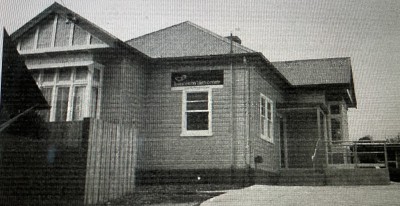
Midwives Emma Ryder and Anna Holloway outside the new premises at 14 Frankland Rise.
Highlights 1996 – 2020
40-Year Celebrations
2024 saw a joyous gathering of over 80 people to celebrate 40 years of LBC: families whose babies were born at the birth centre and local people who have volunteered over the years in fundraising, campaigning and promotional activities in order to keep the project functioning. Guests were treated to wonderful stories from women about their birth experiences.
Midwife Jaimee Smith spoke of the challenges faced in being the only midwife currently available to offer the service and her hopes to recruit and support more midwives to become endorsed and work in the birth centre. Jaimee acknowledged all those who had come before her and highlighted the privilege of her role.
Many of the midwives who worked in the birth centre in the early years were present and were honoured with speeches and presentations of flowers. Their contributions to this unique service were acknowledged and their dedication to providing community-based midwifery continuity of care.
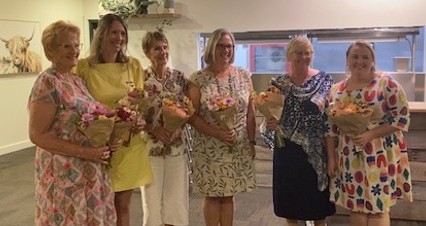
LBC Midwives Anna Holloway, Jaimee Smith, Jennifer Smyth, Athlene Petterwood, Cecily Harmey and Courtney Hayes
Acknowledgements
 This overview of the history of the Launceston Birth Centre (1983 – 2020) has been adapted from one compiled by Jean J. Vasic (retired LBC midwife), drawing on her collection of LBC newsletters and minutes of meetings. The history was initially requested of Jean by LBC midwife Jaimee Smith, in preparation for giving presentations about the LBC and providing statistics about outcomes at the Australian College of Midwives Tasmania Conference, March 2023, Hobart, and the National Endorsed Midwife Conference, July 2023, Townsville.
This overview of the history of the Launceston Birth Centre (1983 – 2020) has been adapted from one compiled by Jean J. Vasic (retired LBC midwife), drawing on her collection of LBC newsletters and minutes of meetings. The history was initially requested of Jean by LBC midwife Jaimee Smith, in preparation for giving presentations about the LBC and providing statistics about outcomes at the Australian College of Midwives Tasmania Conference, March 2023, Hobart, and the National Endorsed Midwife Conference, July 2023, Townsville.
In 2024, following a year of celebrations honouring the 40th year anniversary of the LBC, Alana Street interviewed Jean Vasic on behalf of the ACM Australian Midwifery History Project. Jean gave permission for her account to be published on this website, and provided Alana with extra information to add to her original overview.
A tribute to the late Barbara Purcell, by Jean Vasic
Honourable and respectful mention goes to one of our founding midwives, Barbara Purcell, who died on 21 February, 2020. She is remembered for her work with a team of midwives in the early ’80s to ’90s with LBC and homebirths. Barbara was very active in the promotion of the LBC through public speaking and various education activities for midwives and clients.
Additional material has been added from an article by the late Elaine Smallbane, who worked as a midwife in the LBC from its inception. Elaine passed away at age in June 2016, at age 75. The article is a based on a presentation Elaine gave at the Birth Issues International Conference in Melbourne in 1994
Birth Issues was the bi-monthly publication produced by CAPERS (Childbirth and Parenting Education Resources and Services). It ran from 1992-2006 and for many years, was the only peer-reviewed journal in Australia and New Zealand with a childbirth and breastfeeding focus. Birth Issues was indexed by CINAHL and the Australasian Medical Index (AMI).

This account also includes testimony gathered by Alana Street on behalf of the ACM Australian Midwifery History Project during an informal interview with Anne O’Byrne, AM who played a major role in the initiation of the birth centre, and retired midwife Cecily Harmey, founding member of the LBC (Anne & Cecily pictured here together). Anne O’Byrne has been at the forefront of women’s organisations and health services in Launceston since the early 1960s, and she and Cecily were instrumental in bringing people together to develop and implement the Launceston Birth centre in the early 1980s.
Anne and Cecily shared memories with Alana, and Cecily provided a wealth of documents and press cuttings from her personal collection.
